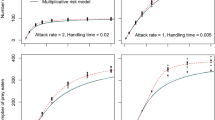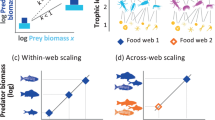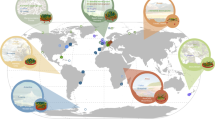Abstract
An understanding of the mechanisms that underlie species distribution and abundance is one of the key problems in population ecology. In order to tackle this problem, it is important to assess the relative strength of the effects of food and predators (consumers) on a focal population. In this study we analysed the advantages and disadvantages of the basic methods that are used to quantify the relative strength of the two types of effects. These methods can be divided into two groups. In the first group, we included the search for examples that are consistent with a proposed hypothesis, the assessment of correlations of abundance at adjacent trophic levels and biomanipulations. What is common for these methods is that they assume the existence of only one type of effect—either bottom-up or top-down. The methods of the second group assume the simultaneous presence of both types of effects and are aimed at quantifying their relative strength. This group includes factorial design experiments and the population-dynamics approach (analysis of population growth, death and birth rates). Here, we have shown that, due to the constraints of each of the methods of the second group, none of them can be considered universal. However, their combined application can be a promising approach to the assessment of the mechanisms that drive population abundance variability, both in experimental and field studies.
Similar content being viewed by others
References
Alimov, A.F., Vvedenie v produktsionnuyu gidrobiologiyu (Introduction to Production Hydrobiology), Leningrad: Gidrometeoizdat, 1989.
Berryman, A.A., What causes population cycles of forest Lepidoptera? Trends Ecol. Evol., 1996, vol. 11, no. 1, pp. 28–32.
Berryman, A. and Turchin, P., Detection of delayed density dependence: comment, Ecology, 1997, vol. 78, no. 1, pp. 318–320.
Bizina, E.V., Ratio of the impact of predators and resource supply in regulation of structure and functions of communities: review of hypothesizes, Zh. Obshch. Biol., 1997, vol. 58, no. 5, pp. 26–45.
Boettiger, C. and Hastings, A., Early warning signals and the prosecutor’s fallacy, Proc. R. Soc. B, 2012, vol. 279, no. 1748, pp. 4734–4739.
Boettiger, C. and Hastings, A., Tipping points: from patterns to predictions, Nature, 2013a, vol. 493, no. 7431, pp. 157–158.
Boettiger, C. and Hastings, A., No early warning signals for stochastic transitions: insights from large deviation theory, Proc. R. Soc. B, 2013b, vol. 280, no. 1766. doi: 10.1098/rspb.2013.1372
Bottrell, H.C., A review of some problems in zooplankton production studies, Norw. J. Zool., 1976, vol. 24, pp. 419–456.
Brooks, J.L. and Dodson, S.I., Predation, body size, and composition of plankton, Science, 1965, vol. 150, no. 3692, pp. 28–35.
Brown, J.H. and Kodric-Brown, A., Turnover rates in insular biogeography: effect of immigration on extinction, Ecology, 1977, vol. 58, no. 2, pp. 445–449.
Carpenter, S.R. and Kitchell, J.F., The temporal scale of variance in limnetic primary production, Am. Nat., 1987, vol. 129, no. 3, pp. 417–433.
Carpenter, S.R., Kitchell, J.F., and Hodgson, J.R., Cascading trophic interactions and lake productivity, BioScience, 1985, vol. 35, no. 10, pp. 634–639.
Dempster, J.P., The population ecology of the cinnabar moth, Tyria jacobaeae L. (Lepidoptera, Arctiidae), Oecologia, 1971, vol. 7, no. 1, pp. 26–67.
Denno, R.F., et al., Bottom-up forces mediate naturalenemy impact in a phytophagous insect community, Ecology, 2002, vol. 83, no. 5, pp. 1443–1458.
Denno, R.F., Gratton, C., Döbel, H., and Finke, D.L., Predation risk affects relative strength of top-down and bottom-up impacts on insect herbivores, Ecology, 2003, vol. 84, no. 4, pp. 1032–1044.
Denno, R.F., Lewis, D., and Gratton, C., Spatial variation in the relative strength of top-down and bottom-up forces: causes and consequences for phytophagous insect populations, Ann. Zool. Fenn., 2005, vol. 42, no. 4, pp. 295–311.
Edmondson, W.T., A graphical model for evaluating the use of the egg ratio for measuring birth and death rates, Oecologia, 1968, vol. 1, nos. 1-2, pp. 1–37.
Elton, C., Animal Ecology, London: Sidgwick and Jackson, 1927.
Fretwell, S.D., The regulation of plant communities by food chains exploiting them, Perspect. Biol. Med., 1977, vol. 20, no. 169, pp. 169–185.
Fretwell, S.D., Food chain dynamics: the central theory of ecology? Oikos, 1987, vol. 50, pp. 291–301.
Gladyshev, M.I., Biomanipulation as a tool for regulation of water quality in continental reservoirs: literature review of 1990–1999, Biol. Vnutr. Vod, 2001, no. 2, pp. 3–15.
Gliwicz, M.Z., On the different nature of top-down and bottom-up effects in pelagic food webs, Freshwater Biol., 2002, vol. 47, no. 12, pp. 2296–2312.
Gripenberg, S. and Roslin, T., Up or down in space? Uniting the bottom-up versus top-down paradigm and spatial ecology, Oikos, 2007, vol. 116, no. 2, pp. 181–188.
Hairston, N.G., Smith, F.E., and Slobodkin, L.B., Community structure, population control, and competition, Am. Nat., 1960, pp. 421–425.
Hanski, I., Metapopulation dynamics, Nature, 1998, vol. 396, no. 6706, pp. 41–49.
Hanson, J.M. and Peters, R.H., Empirical prediction of crustacean zooplankton biomass and profundal macrobenthos biomass in lakes, Can. J. Fish. Aquat. Sci., 1984, vol. 41, no. 3, pp. 439–445.
Hansson, L.-A., The role of food chain composition and nutrient availability in shaping algal biomass development, Ecology, 1992, vol. 73, no. 1, pp. 241–247.
Hassell, M.P., Crawley, M.J., Godfray, H.C.J., and Lawton, J.H., Top-down versus bottom-up and the Ruritanian bean bug, Proc. Natl. Acad. Sci. U.S.A., 1998, vol. 95, no. 18, pp. 10661–10664.
Hunter, M.D., Multiple approaches to estimating the relative importance of top-down and bottom-up forces on insect populations: experiments, life tables, and timeseries analysis, Basic Appl. Ecol., 2001, vol. 2, no. 4, pp. 295–309.
Hunter, M.D. and Price, P.W., Playing chutes and ladders: heterogeneity and the relative roles of bottom-up and top-down forces in natural communities, Ecology, 1992, vol. 73, no. 3, pp. 723–732.
Hunter, M.D., Varley, G.C., and Gradwell, G.R., Estimating the relative roles of top-down and bottom-up forces on insect herbivore populations: a classic study revisited, Proc. Natl. Acad. Sci. U.S.A., 1997, vol. 94, no. 17, pp. 9176–9181.
Ivlev, V.S., Biological productivity of reservoirs, Usp. Sovrem. Biol., 1945, vol. 19, pp. 98–120.
Kasparson, A.A. and Polishchuk, L.V., Analysis of the birth rate in population of Bosmina longirostris, in Tr. konf. “Informatsionnye tekhnologii i sistemy” (Trans. Conf. “Information Technologies and Systems”), Moscow: Inst. Probl. Peredachi Inform., Ross. Akad. Nauk, 2013, pp. 140–145.
Krebs, C.J., Ecology: The Experimental Analysis of Distribution and Abundance, New York: Harper and Row, 1985.
Leibold, M.A., Chase, J.M., Shurin, J.B., and Downing, A.L., Species turnover and the regulation of trophic structure, Ann. Rev. Ecol. Syst., 1997, vol. 28, pp. 467–494.
Lindeman, R.L., The trophic-dynamic aspect of ecology, Ecology, 1942, vol. 23, no. 4, pp. 399–417.
McCauley, E. and Kalff, J., Empirical relationships between phytoplankton and zooplankton biomass in lakes, Can. J. Fish. Aquat. Sci., 1981, vol. 38, no. 4, pp. 458–463.
McQueen, D.J., Post, J.R., and Mills, E.L., Trophic relationships in freshwater pelagic ecosystems, Can. J. Fish. Aquat. Sci., 1986, vol. 43, no. 8, pp. 1571–1581.
Menge, B.A., Community regulation: under what conditions are bottom-up factors important on rocky shores? Ecology, 1992, vol. 73, no. 3, pp. 755–765.
Mittelbach, G.G., Osenberg, C.W., and Leibold, M.A., Trophic relations and ontogenetic niche shifts in aquatic ecosystems, in Size-Structured Populations, Berlin: Springer-Verlag, 1988, pp. 219–235.
Morris, R.F., Single-factor analysis in population dynamics, Ecology, 1959, vol. 40, no. 4, pp. 580–588.
Murdoch, W.W., Community structure, population control, and competition—a critique, Am. Nat., 1966, vol. 100, no. 912, pp. 219–226.
Oksanen, L., Fretwell, S.D., Arruda, J., and Niemela, P., Exploitation ecosystems in gradients of primary productivity, Am. Nat., 1981, vol. 118, no. 2, pp. 240–261.
Olofsson, J., de Mazancourt, C., and Crawley, M.J., Contrasting effects of rabbit exclusion on nutrient availability and primary production in grasslands at different time scales, Oecologia, 2007, vol. 150, no. 4, pp. 582–589.
Paine, R.T., Food web complexity and species diversity, Am. Nat., 1966, vol. 100, pp. 65–75.
Paine, R.T., Food webs: linkage, interaction strength and community infrastructure, J. Anim. Ecol., 1980, vol. 49, no. 3, pp. 667–685.
Paloheimo, J.E., Calculation of instantaneous birth rate, Limnol. Oceanogr., 1974, vol. 19, no. 4, pp. 692–694.
Polis, G.A., Complex trophic interactions in deserts: an empirical critique of food-web theory, Am. Nat., 1991, vol. 138, no. 1, pp. 123–155.
Polis, G.A., Sears, A.W.L., Huxel, G.R., Strong, D.R., and Maron, J., When is a trophic cascade a trophic cascade? Trends Ecol. Evol., 2000, vol. 15, no. 11, pp. 473–475.
Polis, G.A. and Strong, D.R., Food web complexity and community dynamics, Am. Nat., 1996, vol. 147, no. 5, pp. 813–846.
Polishchuk, L.V., Direct positive effect of invertebrate predators on birth rate in Daphnia studied with a new method of birth rate analysis, Limnol. Oceanogr., 1995, vol. 40, no. 3, pp. 483–489.
Polishchuk, L.V., Vijverberg, J., Voronov, D.A., and Mooij, W.M., How to measure top-down vs bottom-up effects: a new population metric and its calibration on Daphnia, Oikos, 2013, vol. 122, no. 8, pp. 1177–1186.
Power, M.E., Top-down and bottom-up forces in food webs: do plants have primacy, Ecology, 1992, vol. 73, no. 3, pp. 733–746.
Preszler, R.W. and Price, P.W., Host quality and sawfly populations: a new approach to life table analysis, Ecology, 1988, vol. 69, no. 6, pp. 2012–2020.
Ricker, W.E., Stock and recruitment, J. Fish. Board Can., 1954, vol. 11, no. 5, pp. 559–623.
Rosenzweig, M.L., Exploitation in three trophic levels, Am. Nat., 1973, vol. 107, pp. 275–294.
Rosenzweig, M.L. and MacArthur, R.H., Graphical representation and stability conditions of predator-prey interactions, Am. Nat., 1963, vol. 97, pp. 209–223.
Schmitz, O.J., Hambäck, P.A., and Beckerman, A.P., Trophic cascades in terrestrial systems: a review of the effects of carnivore removals on plants, Am. Nat., 2000, vol. 155, no. 2, pp. 141–153.
Shapiro, J., Biomanipulation: the next phase—making it stable, Hydrobiologia, 1990, vols. 200/201, pp. 13–27.
Shapiro, J. and Wright, D.I., Lake restoration by biomanipulation: Round Lake, Minnesota, the first two years, Freshwater Biol., 1984, vol. 14, no. 4, pp. 371–383.
Silvertown, J., Poulton, P., Johnston, E., Edwards, G., Heard, M., and Biss, P.M., The Park Grass Experiment 1856–2006: its contribution to ecology, J. Ecol., 2006, vol. 94, no. 4, pp. 801–814.
Slobodkin, L.B., Smith, F.E., and Hairston, N.G., Regulation in terrestrial ecosystems, and the implied balance of nature, Am. Nat., 1967, vol. 101, no. 918, pp. 109–124.
Stiling, P., Density-dependent processes and key factors in insect populations, J. Anim. Ecol., 1988, vol. 57, pp. 581–593.
Strong, D.R., Are trophic cascades all wet? Differentiation and donor-control in species ecosystems, Ecology, 1992, vol. 73, no. 3, vol. 747–754.
Thompson, W.C. and Schumann, E.L., Interpretation of statistical evidence in criminal trials: the prosecutor’s fallacy and the defense attorney’s fallacy, Law Hum. Behav., 1987, vol. 11, no. 3, pp. 167–187.
Turkington, R., Top-down and bottom-up forces in mammalian herbivore-vegetation systems: an essay review, Botany, 2009, vol. 87, no. 8, pp. 723–739.
Underwood, N. and Rausher, M.D., The effects of hostplant genotype on herbivore population dynamics, Ecology, 2000, vol. 81, no. 6, pp. 1565–1576.
Varley, G.C. and Gradwell, G.R., Key factors in population studies, J. Anim. Ecol., 1960, vol. 29, no. 2, pp. 399–401.
Vinberg, G.G., Study of photosynthesis and respiration in the lake water. Balance of organic matter, Tr. Limnol. Stn. Kostine, 1934, vol. 18, pp. 5–24.
Vinberg, G.G., Diversity and integrity of life phenomena and quantitative methods in biology, Zh. Obshch. Biol., 1981, vol. 42, no. 1, pp. 5–18.
Walker, M. and Jones, T.H., Relative roles of top-down and bottom-up forces in terrestrial tritrophic plant–insect herbivore–natural enemy systems, Oikos, 2001, vol. 93, no. 2, pp. 177–187.
Wilmers, C.C., Post, E., Peterson, R.O., and Vucetich, J.A., Predator disease out-break modulates top-down, bottom-up and climatic effects on herbivore population dynamics, Ecol. Lett., 2006, vol. 9, no. 4, pp. 383–389.
Yamamura, K., Key-factor/key-stage analysis for life table data, Ecology, 1999, vol. 80, no. 2, pp. 533–537.
Yan, N.D., Empirical prediction of crustacean zooplankton biomass in nutrient-poor Canadian Shield lakes, Can. J. Fish. Aquat. Sci., 1986, vol. 43, no. 4, pp. 788–796.
Author information
Authors and Affiliations
Corresponding author
Additional information
Original Russian Text © A.A. Kasparson, 2015, published in Zhurnal Obshchei Biologii, 2015, Vol. 76, No. 2, pp. 111–125.
Rights and permissions
About this article
Cite this article
Kasparson, A.A. Assessing the relative strength of the effects of food resources and predators on a population: A review of methods. Biol Bull Rev 6, 11–23 (2016). https://doi.org/10.1134/S2079086416010023
Received:
Published:
Issue Date:
DOI: https://doi.org/10.1134/S2079086416010023




